Inside the black mass of Mexican sorcerer Enrique Marthen
On the first Friday of March, tourists flood the town of Catemaco to celebrate its annual witchcraft festival
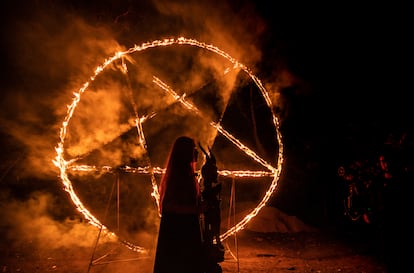

It was just after midnight. The goat looked nervously at the people crowding around, and then his body went limp. The people were gathered at the Catecamo (Veracruz, Mexico) home of Enrique Marthen, a self-proclaimed sorcerer celebrating a black mass – a Satan-worshipping ceremony. No one could see clearly, but everyone heard the goat screeching as the sorcerer slit its throat. An uneasy silence followed the sacrifice. Satan worshippers waited impatiently to be anointed with goat blood, while social media influencers wondered how to explain what they had seen to their followers. And this was only the first act.
Catemaco basked in tranquility the day before, except when conversations turned to the annual witchcraft festival. The vitriol between opposing sides is on full display in the central plaza where town officials hung a banner in front of the Roman Catholic Basilica of Nuestra Señora del Carmen announcing the activities for the annual witchcraft festival. On the first Friday of March, the town’s witches and sorcerers celebrate a black mass in the privacy of homes to dispel the bad energy accumulated over the last year. City officials stage witch parades, concerts, and spiritual cleansing ceremonies to attract more tourists – about 10,000 every year.
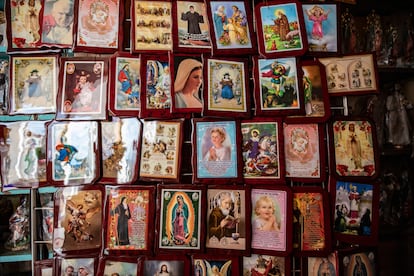
Martín sings softly as he mops the basilica floor with broad strokes. “Ignorance leads people to the Devil,” says the young man quietly. “When you ask Satan for something, he always wants something in return. God’s gifts are free, but you must make an effort.” To counter the evil of the witchcraft festival, the Catholic Church scheduled purification and prayer events. “The only true way is God,” said Martín as he took up his mop again.
Before this modern spectacle began, Catemaco was known for its shamanism and healing rites, a syncretic blend of indigenous practices and the Roman Catholic religion imposed by the conquistadors. Slaves from Cuba brought their tradition of Santeria, creating a breeding ground for mysticism and occult practices. Local resident Dagoberto Escobar Pereira is a former journalist, publicist and construction worker who has lived through the changes that turned Catemaco into an international center for witchcraft. The 77-year-old man is a long-time devoted Christian.

“He tempted me once,” said Escobar, sitting in the central plaza with the basilica behind him.
“The Devil?”
“Yes, it was the first Friday of March, and I was sitting on the sidewalk. I felt desperate because I had many problems. A beautiful horse passed on the street – it had no reins. The horse turned to look at me, but I said, ‘No, I belong to my most holy father – don’t come to tempt me.’ I looked at the clock – it was 12:00am. I wondered why such a beautiful horse was loose because it looked well-cared for and belonged to someone with money. I never touched him.”
Escobar tells us more stories. His clothes are old and a bit too big. His mustache and fingers are yellow from smoking. Everyone, even Catholics, knows the traditional hexes. Place a broom upside down behind the front door if you want a visitor to leave your house. “And the visitor will leave,” said Pereira matter-of-factly.
The sorcerers of today are something new. “That’s a modern thing. We didn’t have all that greed for money because there was no communication. But we have free will. People can do what they want – it doesn’t bother me. It’s part of our culture and brings a lot of tourism to the town,” said Escobar.

Prelude to Act One
It’s 10pm, and a small crowd has gathered in Enrique Marthen’s house. Maria Mata sits, waiting for the ceremony to begin. She has long eyelashes and wears a low-cut red dress and several necklaces with protective amulets. She exudes self-confidence because the town’s senior sorcerer changed her life last year.
“I was in an awful state, and no one could help me. I spent three years going to a psychologist, but it wasn’t working,” said Mata, who has come all the way from California. Her life began to change when she first came to this out-of-the-way house on the outskirts of Catemaco. “Now I know who I am and am self-confident. I don’t need anyone else, and I’m not emotionally dependent like before. I have my feet on the ground,” she said. “My children can sense that energy, which has changed my life.” Other people told similar stories – they were in dire straits when Enrique Marthen rescued them from the darkness. The sorcerer enters through the front door. He is dressed in a golden robe and carries a staff topped with an animal head.
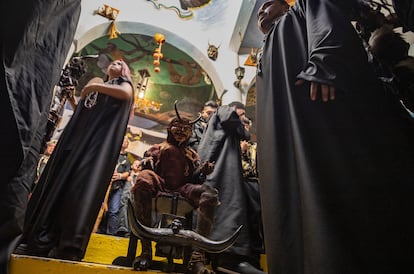
Act One
The six-pointed star painted on the floor is covered with bottles of tequila offered as gifts by visitors. The dancers finish performing, and one of the sorcerers readies himself to speak. Drones buzzing overhead record the ceremony. “We are for indulgence instead of abstinence – we stand for unfettered freedom,” he declares to the 100 people gathered there. Enrique Marthen steps up to the microphone. “We will now proceed with the sacrifice of life,” he says. The atmosphere suddenly becomes tense. An innocent, oblivious goat is led to the center. Dressed in tight red-leather outfits, Marthen’s aides form a circle around the goat and cover it with a black tarp. Marthen pulls a dagger from its sheath and displays it to the audience. “Please, don’t take pictures of this because of censorship,” he whispers.
Marthen crouches next to the goat. No one can see what’s happening, but his microphone is on, and the goat’s bleating says it all. “Speak!” he demands as he cuts off its head. “Speak!” Someone shouts, “Hail Lucifer!” The animal falls silent. One of the sorcerers has collected a bowl of goat blood. “Strength, power, healing,” everyone says in unison. Marthen ascends a small, pyramidical altar with an upside-down cross. He puts the goat blood bowl on the floor and pulls out a hospital blood bag.
“Tonight, for the first time, we will shed human blood,” said Marthen. “Someone donated this blood today, which will be spilled over this pyramid as in ancient times.” Marthen slices the bag with the knife, and blood spills down the pyramid’s steps. Deep, intense music throbs from the speakers. “May this blood wash away all the problems, all the negativity in our lives,” he declares. Marthen then dips a few pirul (pepper tree) branches in the goat blood and sprinkles the crowd. Some people come forward to get more blood and smear it on their faces while the YouTubers record everything. The goat’s head is severed and saved for later, and the cadaver is thrown behind some bushes.
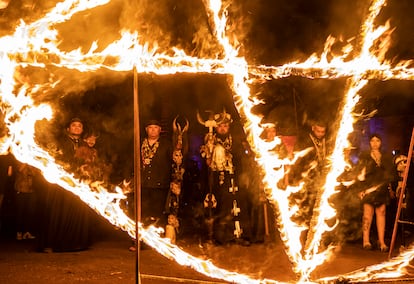
Act Two
A naked Satan figure presides over the private ceremony in a cave illuminated by red lights. About 40 people with press credentials wait outside. Two journalists from EL PAÍS are invited inside, where three young girls swathed in thin, black cloth sit around a table, undulating slowly. It’s suffocatingly hot in the packed room. Without much fanfare, Marthen tells the crowd to petition Satan for a need in the coming year. When everyone has finished, Marthen opens a bottle of wine and tells the girls to reveal themselves. They remove the black garments to display nearly nude bodies wrapped with leather garters. The sorcerer sprinkles their bodies with wine while they writhe like snakes as the ceremony concludes. The people walk backward from the room to avoid turning their backs on the demon. Most are sweating, and their faces glisten with fatigue and rapture.

Act Three
The final act is staged in Mexico’s unfinished First Church of Satan. The goat head sits on a table with pirul branches for cleansing and a satanic prayer book. Prayers are read before Enrique Marthen approaches the six-pointed star and silently sets it ablaze. “Long live Lucifer,” shouts the crowd in the red light of the bonfire.
Enrique Marthen Berdón was born in Catemaco and raised in the Roman Catholic Church, which teaches that the devil is dark and dangerous. He spent years working in the United States and often performed cleansings for close friends. Marthen began to read and educate himself about psychology, logic, philosophy, and sacred texts. “The Catholic Church turned Lucifer into an evil being even though the name Lucifer means ‘of the light,’” said Marthen.
Marthen decided to return to Catemaco and dedicate himself to witchcraft. Echoing Martín, the young Christian man we met mopping the basilica’s floor, Marthen says you must make an effort. “You don’t have to give your soul to the Devil, but you have to work for what you want to achieve,” said Marthen. Politicians, businessmen and street sweepers alike have used his services. “Everyone is important, so I attend to everyone equally.”
“Does the street sweeper ask for the same things as the businessman?”
“In this world, everyone wants the same thing. Someone with nothing only wants a little. Someone with little wants to have more, and someone with a lot wants twice as much. There is too much obsession with money in this world. I try to guide them, but ultimately, everyone has to follow their own path.”
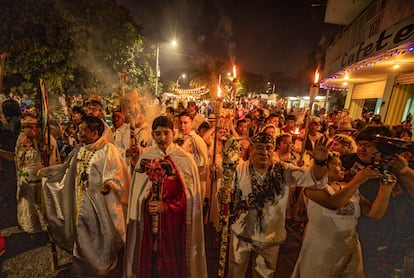
Sign up for our weekly newsletter to get more English-language news coverage from EL PAÍS USA Edition
Tu suscripción se está usando en otro dispositivo
¿Quieres añadir otro usuario a tu suscripción?
Si continúas leyendo en este dispositivo, no se podrá leer en el otro.
FlechaTu suscripción se está usando en otro dispositivo y solo puedes acceder a EL PAÍS desde un dispositivo a la vez.
Si quieres compartir tu cuenta, cambia tu suscripción a la modalidad Premium, así podrás añadir otro usuario. Cada uno accederá con su propia cuenta de email, lo que os permitirá personalizar vuestra experiencia en EL PAÍS.
¿Tienes una suscripción de empresa? Accede aquí para contratar más cuentas.
En el caso de no saber quién está usando tu cuenta, te recomendamos cambiar tu contraseña aquí.
Si decides continuar compartiendo tu cuenta, este mensaje se mostrará en tu dispositivo y en el de la otra persona que está usando tu cuenta de forma indefinida, afectando a tu experiencia de lectura. Puedes consultar aquí los términos y condiciones de la suscripción digital.
More information
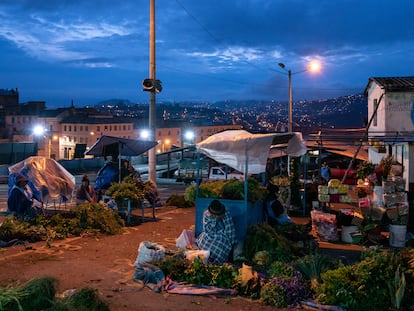
The craft of healing with plants: How Andean medicine is being kept alive
Archived In
Últimas noticias
There is as much life left to discover on planet Earth as that which is already known
Dozens presumed dead, around 100 injured in fire at Swiss Alps bar during New Year’s celebration
Is porn for women different from conventional porn? We spoke to those who make it
Cartagena de Indias is sinking: What can the city do to mitigate it?
Most viewed
- Reinhard Genzel, Nobel laureate in physics: ‘One-minute videos will never give you the truth’
- David King, chemist: ‘There are scientists studying how to cool the planet; nobody should stop these experiments from happening’
- Sinaloa Cartel war is taking its toll on Los Chapitos
- Oona Chaplin: ‘I told James Cameron that I was living in a treehouse and starting a permaculture project with a friend’
- The Interoceanic Train, the Mexican alternative to the Panama Canal









































